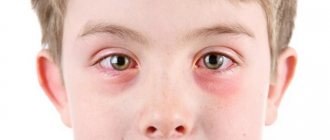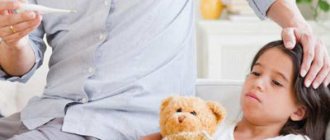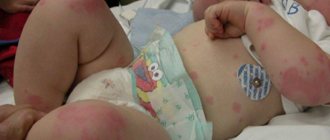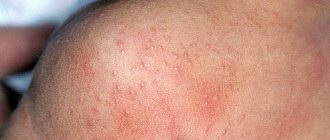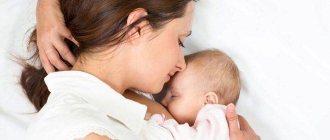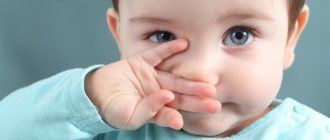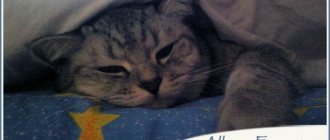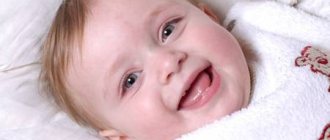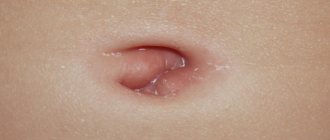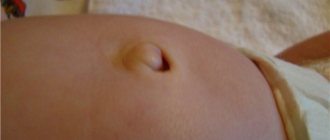Other symptoms
IT IS IMPORTANT TO KNOW!
Urticaria in a child is a rare case when the photo completely reflects the symptoms.
Treatment for urticaria requires only external manifestations, since other symptoms, provided there are no underlying causes and complications, are not observed.
What is urticaria in newborns
Urticaria in infants is a type of dermatitis. In most cases, it is of an allergic nature. Almost immediately after contact with a dangerous object, the first symptoms appear, including:
- acute itching;
- skin redness;
- small blisters;
- swelling.
The swelling resembles the marks of a nettle “bite” – hence the name of the pathology.
Symptoms of general malaise and a slight rise in temperature occur less frequently. In an acute attack, Quincke's edema may develop, which affects the baby's lungs and can be fatal.
“Mild” urticaria goes away on its own within 1.5-2 hours. In severe forms, symptoms gradually increase, and the rash lasts for several days.
In this case, parents need to contact their pediatrician as soon as possible to identify the provoking factor and eliminate it.
Causes
The main reason for the appearance of rashes and blisters is an inadequate immune response to potentially dangerous irritants. In young children, it appears due to the fact that the immune system is not fully formed and the body reacts sharply to any influence.
Urticaria can be triggered by:
- food allergies;
- pollen and plant sap;
- synthetics and wool;
- heat or cold;
- stress;
- infections;
- animals;
- medications.
Children from one to two years old are in the greatest risk zone. Usually complementary foods are introduced at this time, and the reaction to new foods is unpredictable. After three years, the immune system becomes stronger, and irritants do not affect the baby as much.
Newborns who are breastfed rarely develop urticaria.
The fault usually becomes the mother, who violated the diet. Strawberries, chocolate, citrus fruits or natural honey can trigger allergies. It is worth considering that urticaria is not always allergic in nature.
Why hives may appear in a baby, watch this video:
In rare cases, symptoms appear due to more serious disorders - tumors, diabetes or parasite infection. To be sure to find out the cause of the rash, you need to conduct a full examination of the baby.
First aid for urticaria in infants
To quickly get rid of the unpleasant symptoms of urticaria, you need to immediately exclude the child from contact with a potential irritant. If the baby has a food allergy, an enema is given or a natural sorbent is given.
Activated carbon or Smecta are usually used. Antihistamines are given to older children, but they are usually not available to infants. It may be necessary to change clothes or remove the animal from the premises.
If the reaction is caused by pollen or cosmetics, the child should be bathed in warm water without using soap or shampoo. The hives rash is accompanied by severe itching, but the spots should not be scratched.
To reduce discomfort, mild baby creams or ointments with a cooling effect are used. Folk remedies that include only natural herbal ingredients are also used.
You need to choose the most neutral composition so as not to aggravate the baby’s condition.
Other types of illness
In children 5 years of age and older, the symptoms of urticaria in the photo may appear more specific, and treatment in this case is also complicated. For example, with solar urticaria, long-term contact with ultraviolet radiation is contraindicated for a child. There is a need to constantly use sunscreen.
Causes
Papular urticaria is the result of exposure to the secretion of arthropod insects, which they secrete when they bite. An atypical delayed response of the immune system to the allergen develops. Upon contact with the skin, insect saliva acts as a toxin, damaging its cells, which contributes to an increased release of histamine, a mediator of allergies. Most often, papular urticaria is diagnosed from late spring to early autumn, when there are a lot of insects on the street.
Any type of urticaria can transform into papular urticaria if it is not correctly diagnosed and treated incorrectly. In this case, instead of urtic rashes, papules appear as a process of joining the cellular infiltrate to the existing skin edema. Any factor that can cause urticaria can affect the occurrence of papules. This requires an allergen, high skin sensitization, and time.
Mast cells trap the allergenic substance where it enters the skin. Even if the irritant continues its impact, causing new rashes, the pathology will not spread beyond the skin.
Find out effective treatments for foot allergies in adult patients.
A breakdown of the 20 allergen respiratory panel results can be seen on this page.
Additional provocateurs of papular urticaria can be:
- physical indicators (changes in air temperature, pressure);
- increased physical activity;
- Ural Federal District;
- Food;
- taking medications.
The disease is chronic and can appear on the skin for up to several months. Therefore, it is also called “persistent urticaria”.
Tests before treatment
No matter how clearly the photo conveys the symptoms of urticaria in children, treatment of the disease begins after obtaining laboratory test data. As a standard, you will need to do general blood and urine tests, a biochemical and blood test for hepatitis, a test for syphilis and specific IgE to allergens.
Urgent care for urticaria
In some cases, urticaria develops very rapidly and poses a danger to the child’s life. You should urgently call an ambulance (and in order not to waste time, it is better to go to the hospital directly with your car) if you observe the following signs accompanying urticaria:
A combination of the following symptoms also requires urgent consultation with a doctor:
In a critical situation, when dangerous symptoms develop, it is necessary to immediately give the child any antiallergic drug. Under no circumstances should he allow him to breathe quickly and shallowly, as happens when he is frightened. Take the child in your arms, calm him down, and begin to breathe calmly and deeply with him.
If you are waiting for the ambulance to arrive, then lay the patient on a horizontal surface, open the window and unfasten the collar. Do not leave your child in a serious condition even for a second!
Treatment
Treatment of the disease, including its skin manifestations, lasts on average 4-6 weeks. Without treatment, even allergic urticaria in children can result in a host of side symptoms. Photos of complications, as an example, are shown above.
WE RECOMMEND YOU TO WATCH:
Classification of urticaria
- It is customary to distinguish acute urticaria when symptoms of the disease are observed for up to 6 weeks. In the chronic form, the presence of rashes is noted over a long period of time (more than 6 weeks).
- According to the mechanism of development, urticaria can be allergic, non-allergic, and, when the cause of urticaria remains unknown even after numerous studies, idiopathic.
In addition to a truly allergic disease, children often experience mechanical urticaria that is not associated with allergies (dermographic and cold).
The latter is manifested by the appearance of blisters shortly after exposure to cold. Dermographic urticaria occurs when taking anti-inflammatory non-steroidal drugs, antibiotics, or after suffering from infectious diseases.
Help and therapeutic measures
Parents must understand that if a rash is detected, you should not self-medicate. The child must be examined by a doctor and prescribed emergency treatment appropriate to the patient’s condition. If suspicious rashes appear, you should immediately consult a doctor, since if adequate treatment is not prescribed, Quincke's edema is possible. The disease is diagnosed based on an examination by a pediatrician and an allergist. In the chronic form of the disease, a number of clinical studies are prescribed:
- clinical blood test;
- C-reactive protein test.
Treatment must be comprehensive and individual for each patient. Therapeutic measures, as well as medications, are selected by a dermatologist. The algorithm of actions is as follows:
- determination of the allergen based on the results of laboratory tests, its elimination;
- cleansing the body and skin;
- drug therapy;
- strict adherence to the diet.
Throughout the entire period of treatment, the patient must adhere to a healthy lifestyle. You should avoid underwear and clothing made from synthetic fabrics. Taking any medications should also be avoided, the only exception being those drugs that are selected by a specialist.
First aid for a child
If we are talking about the acute stage of urticaria, the rash often goes away within 48 hours without any additional action. In such a situation, it is much more important to help the child survive the itching caused by the rash. Therefore, it is important to relieve itching at the initial stage.
First of all, you need to exclude the effect of the allergen. As a rule, this is a pet, a product, or medications. Then you need to apply a gel or cream with an anti-allergenic effect to the skin, corresponding to the age category of the child. If you don’t have such a drug in your medicine cabinet, use an anti-burn agent or apply a compress of vinegar solution (dilute a tablespoon of vinegar in a glass of water).
If there is a rash, do not scratch the skin. It is necessary to trim your nails as short as possible. You should avoid synthetic clothing, it provokes irritation; it is better to use only cotton items.
Eliminating symptoms
Urticaria in a child 3 years of age and older is accompanied by nausea, rapid pulse, difficulty breathing, profuse sweating, fever and confusion. You should immediately call an ambulance, and until doctors arrive, you need to provide the patient with something to drink. It is best to prepare an alkaline solution - dissolve 1 g of baking soda in a liter of water. If it is impossible to prepare an alkaline solution, use mineral water with a slightly alkaline composition. It is imperative to give the child an enterosorbent to cleanse the digestive system of the allergen.
If swelling and rash occur as a result of a bite, after administering the medication, you need to bandage the area slightly above the injection or bite fairly tightly.
Drug therapy
Antihistamines for the treatment of urticaria for children - tablets and ointments - are prescribed to relieve symptoms. It should be noted that doctors today do not prescribe first-generation drugs to patients and select the latest generation of histamine receptor blockers. This is explained by the fact that earlier produced drugs cause a number of unwanted strong side effects:
- dry mucous membranes;
- with bronchial asthma, the viscosity of sputum increases;
- intraocular pressure increases;
- disturbances in psychomotor functions are observed;
- there is urinary retention.
Later generation drugs do not cause side effects. In addition, they are easy to use and safe for children. According to statistics, all antihistamine medications are easily tolerated by patients, and such a factor as individual intolerance is practically excluded.
A sorbent will help cure food urticaria; it is given to the child to cleanse the intestines - “Enterosgel”, “Smecta” or “Lactofiltrum”.
Treatment of idiopathic urticaria involves following a special diet and taking medications prescribed by a doctor. The diet is selected individually, based on the patient’s condition, test results and allergy tests. A specialist may also prescribe a soft sorbent, for example, Hemodez, and, if necessary, additional digestive enzymes.
Other drugs for urticaria
As noted earlier, urticaria requires complex treatment. Only a systematic approach will ensure a positive result. According to statistics, the treatment of urticaria is favorable and will soon give a positive result. Additional drugs:
- for acute urticaria pigmentosa, injections of antihistamines are administered - “Tavegil”, “Fenkarol”;
- if antihistamines do not have the desired effect, corticosteroids are prescribed - Dexamethasone or Prednisone;
- enterosorbents are prescribed to cleanse the intestines - “Enterosgel” or “Smecta”;
- be sure to use ointments and gels to neutralize swelling and itching;
- Excess fluid is removed from the body using diuretics, for example, Furosemide;
- if necessary, the doctor prescribes sedative medications and means to strengthen the walls of blood vessels.
Autoimmune urticaria, which occurs in severe form, requires hospitalization of the child. In this condition, the baby requires constant monitoring by a specialist and administration of drugs in a hospital setting. Patients are prescribed higher doses of antihistamines as well as corticosteroids.
Ointments and gels for urticaria
First of all, external preparations are divided into two groups - hormonal and non-hormonal. Regardless of the composition, the drug is applied according to a certain scheme:
- thin layer;
- exclusively on foci of inflammation;
- only as directed or recommended by a physician.
Allergists note that the most effective ointments contain hormones. Hormonal drugs are used only as prescribed by a doctor - a specialist determines how long the treatment will last and the frequency of application of the drug. Since urticaria is often accompanied by irritability, the doctor must select sedatives.
It is strictly forbidden to apply a product containing hormones to areas of skin with open wounds.
It should be noted that hormonal external agents are advisable to use when the disease is severe. First, the doctor selects non-hormonal therapy; if such treatment is ineffective, they move on to more intensive medications. Hormone therapy is carried out under the supervision of a dermatologist.
The best hormonal ointments for urticaria
It should be taken into account that with prolonged use of hormonal ointments, addiction to the drug is possible, and accordingly, the effectiveness decreases.
| Drugs | Description |
| "Advantan" | The latest generation steroid drug. Effectively eliminates the symptoms of urticaria - irritation, swelling, itching. The drug is quickly absorbed and must be applied once every 24 hours. In pharmacies, ointment is available in three types: for dry, normal skin type and for skin with weeping lesions. The drug can be applied for a limited period of time, determined by the doctor. The product is well tolerated. |
| "Prednisolone ointment" | The main component of the ointment is prednisolone, which guarantees rapid elimination of urticaria symptoms. The drug is contraindicated in infectious pathologies. Possible side effects - active hair growth, burning sensation. |
| "Elokom" | Neutralizes swelling and inflammatory effect. Used once every 24 hours. Most effective for ultraviolet allergies. Possible side effects - a burning sensation, in patients under 18 years of age there is a slowdown in the synthesis of adrenal hormones. |
| "Lorinden S" | The main component is clioquinol, it relieves itching, swelling, and additionally has antifungal and anti-inflammatory effects. The product is applied twice a day, the course is 14 days; with longer use, tissue necrosis is possible. Ointment is not prescribed for children. |
| "Soderm" | The main component is betamethasone, presented in different dosage forms - lotion, ointment. The drug is prescribed to adults, but in exceptional cases and under the supervision of a specialist it can be used to treat one-year-old children and older children. |
| "Gistan N" | The composition contains a glucocorticosteroid, which eliminates inflammation and swelling. Prescribed for children over two years of age. Not used for fungal, viral, or bacterial infections. The ointment has certain disadvantages - it is not used on large areas, it may increase the burning sensation. If unpleasant symptoms intensify, use of the ointment should be stopped immediately. |
Hormonal ointments are strictly forbidden to use in the presence of cuts and open wounds on the skin. Do not use ointment based on hormones for longer than the period specified in the instructions. It is also important to follow the dosage.
Non-hormonal drugs
They are effective, but unlike hormonal ones they cause side effects. Such ointments are prescribed when urticaria is mild and does not require long-term treatment.
| A drug | Description |
| "Zinc ointment" | The drying agent is in great demand due to its effectiveness and low cost. It has a complex effect - antimicrobial and anti-inflammatory. Approved for treatment during pregnancy, lactation and even infants. The product should be applied 4 to 6 times a day. Individual intolerance to the ingredients of the ointment is possible. |
| "Fenistil gel" | It has a complex effect - antiallergic and antihistamine. Quickly eliminates itching and stops the spread of the rash. Effective against insect bites. Side effects are possible in the form of headaches, nausea, and in case of overdose, convulsions occur and blood pressure decreases. The gel is prohibited from being applied to open wounds; it is also not prescribed to pregnant women or during lactation. |
| "Nezulin" | The drug is based on natural ingredients, is effective, has an immediate cooling effect, and quickly relieves itching, swelling, and redness. Has no age restrictions. |
| "Skin-up" | Prescribed for children, it acts quickly and eliminates itching. It contains exclusively natural ingredients - herbal extracts (chain, licorice), panthenol. The drug can be applied to skin with small cracks. The ointment is suitable for long-term use. |
Non-hormonal drugs can be used by everyone. They do not guarantee quick results, unlike hormonal medications. They are prescribed for the initial stage of urticaria, for infants (the first year of life).
